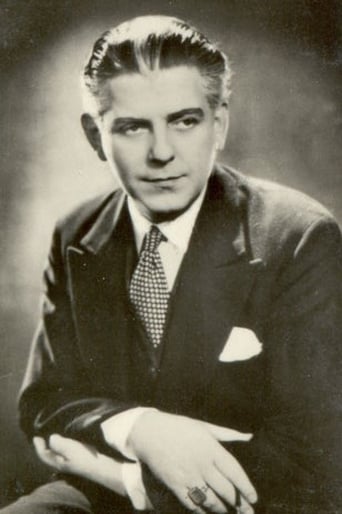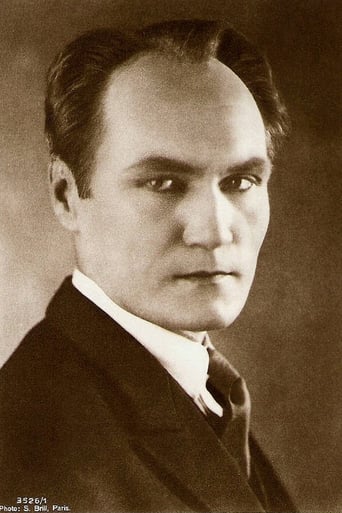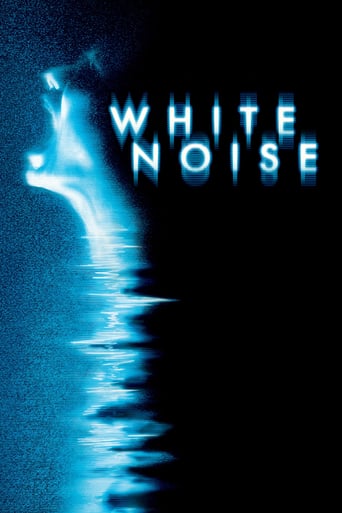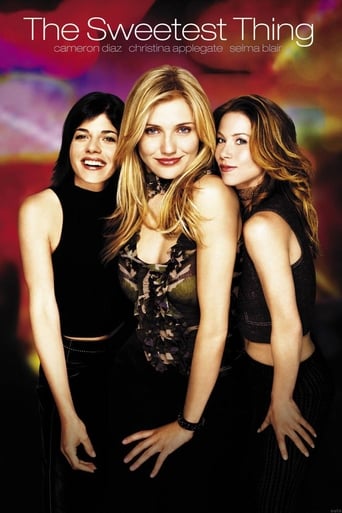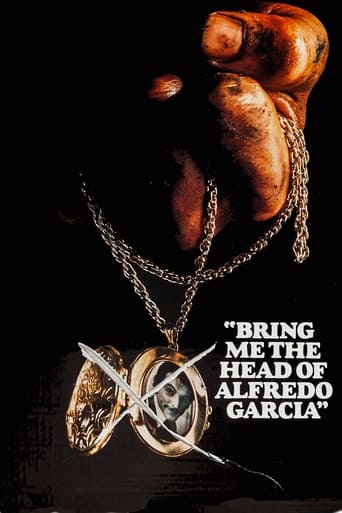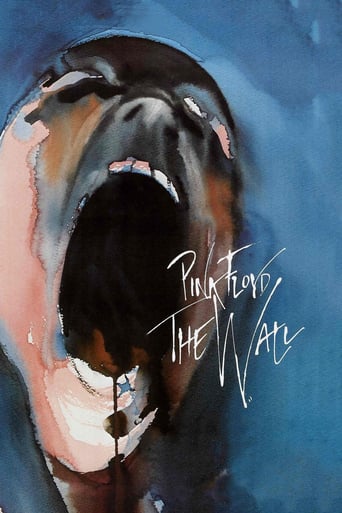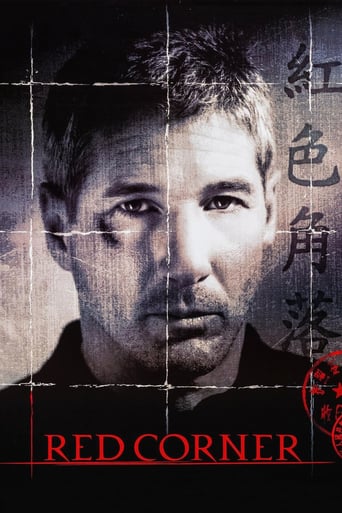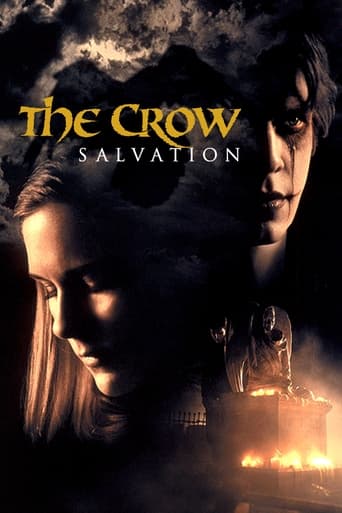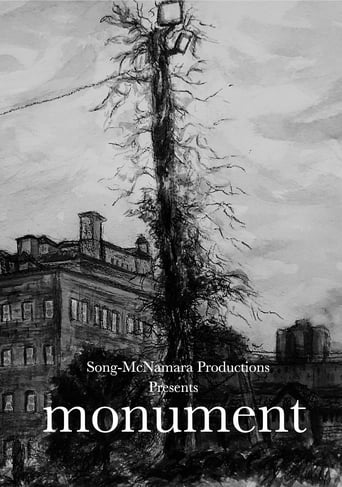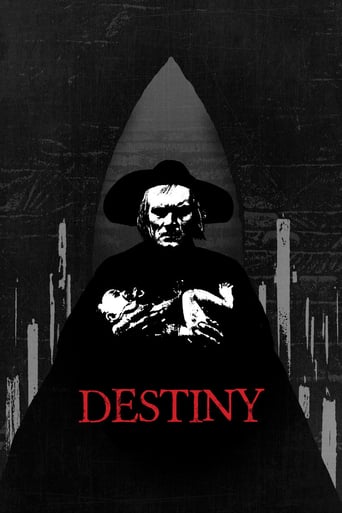
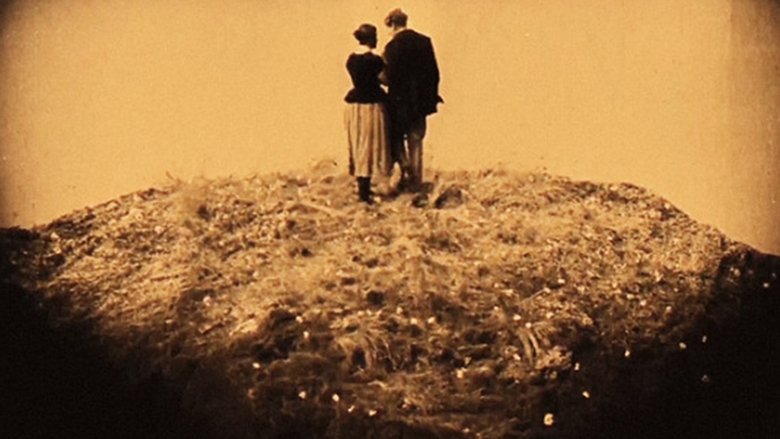
Destiny (1921)
As a young couple stops and rests in a small village inn, the man is abducted by Death and is sequestered behind a huge doorless, windowless wall. The woman finds a mystic entrance and is met by Death, who tells her three separate stories set in exotic locales, all involving circumstances similar to hers.
Watch Trailer
Cast


Similar titles
Reviews
Watched it on the big screen, big happiness. I expected music, but there was none, was watching it in complete silence except for the humming of the projector. And the mumbles of the old guy who talked to himself. It was a little unusual at first, but perfect and beautiful. Death takes the life of a young man, and his girl goes to heaven hell limbo whatever and there gets three chances to save his life, saving either one of three lives. Every one of these stories is set in a different historic age and that tickled my love for the costumed period pieces. First part is the 1001 Night Persia with some impressive action sequences, second is the renaissance Venice, the least interesting or innovative part of the film, and the third is the ancient China, a comic segment with innocent racist depiction of Chinese people, perfect special effects, flying carpet, miniature army, biggest sword ever and transfiguration spells. The closing sequence is somewhat intense. Sets are not as artistic as in Caligari, but more than in Nosferatu. To compare it with two other German expressionist films I watched. Special effects are impressive, better then in some films made even 40 years later. Bernhard Goetzke (Death) is brilliant, so scary, charismatic, constant. The girl is tepid, no skill nor sex appeal.
In 1920's France was known for its impressionism, Soviet Union for its montage cinema and Germany for its expressionism. Both F.W. Murnau and Fritz Lang are usually seen as the biggest representatives of it. Murnau's Faust (1926) and Lang's Der müde Tod have taught us year after year what is German expressionism, and I could bet that both of these films are in every film school's curriculum. Der müde Tod is often translated as The Three Lights or Destiny, but a more accurate translation would be Tired Death. It tells the story of a young couple in love, who arrive to a small German village and soon become acquainted with Death.When researching the history of cinema it is good for one to take a perspective, from which one starts to look at the films. One perspective I myself enjoy is correspondances. The loyal partner for Lang's Der müde Tod can be found easily; F.W. Murnau's Nosferatu (1922). They're both full of suggestive Gothic and expressionistic imagery. Both Murnau and Lang define a zone in their Gothic masterpieces. The zone in between of physic and metaphysic, life and afterlife, real and surreal. Fritz Lang was able to create poetry of imagination, which changed cinema for ever and left a permanent influence on such artists as Luis Bunuel, Jean Cocteau and Georges Franju.Der müde Tod portrays man in front of an eternal problem which is why the common translation Destiny isn't that bad at all. Fritz Lang shows us death, which awaits us all like destiny, something which cannot be avoided. The storyline has taken a lot of influence from expressionistic theater and German folks tales; the characters have no names. The character Death is tired of earning his salary: he's tired of seeing death and agony, misery and suffering of man. The tired Death resembles a modern day bureaucrat but also a responsible hard-working man.Fritz Lang got an incredibly crew to make this film with him which is why it is often seen as his breakthrough. He was able to create the fantastic Bagdad, Venice, ancient China and timeless German village. Even that this is seen as one of the greatest examples of German expressionism, the expressionism of it is very subtle. The most suggestive images are simplified, minimalist, powerful and unforgettable; the wall and the dream-like room of different kind of candles, each of which represent one human life.In the story when Death comes and takes the Man with him the Woman is ready to do anything. Her love is so strong that she doesn't want to live without her love. Death offers her a deal at the room of candles; if she is able to save one of the three candles from fading away she will have her love back. Der müde Tod grows out to be a beautiful study of humanity but at the same manages to be one of the most entertaining films of the era.As the Woman desperately tries to save the candles and afterwards find a life to sacrifice for Death, which would result her to get the Man back, we're able to see how Lang builds this humane tale. The Woman proves her humanity as she saves the baby from the burning building and is willing to die for another. All this makes Der müde Tod sound like a very dark and serious film, which it is, but paradoxically it's also one of the most humorous ones by Fritz Lang. Der müde Tod is an unforgettable masterpiece and no lesser compared to its companion Nosferatu. It's a study about the essence of humanity, filled with unforgettable expressionistic imagery.
The biographical entry for Fritz Lang in the invaluable World Film Directors reference book offers a revealing quote. It seems that when he was a teenager he became gravely ill, and at the peak of his delirium experienced a vivid hallucination. As Lang later described it, "I saw myself face to face, not terrifying, but unmistakable, with Death . . . I don't know whether I should call the feeling I experienced at that moment one of fear. It was horror, but not panic. I recovered quickly, but the love of death, compounded of horror and affection . . . stayed with me and became a part of my films." Lang, who was Austrian, served in the Army during the First World War where he saw considerable combat and, of course, encountered death on a horrific scale. (He also lost the use of his right eye.) While still in the service he launched his career in the movies by submitting screenplays to producer Joe May, and soon afterward acted in two of May's films, playing the Angel of Death in "Hilde Warren und der Tod." Lang began directing in 1919 and was successful almost immediately but remained largely unknown outside Germany until his first genuinely personal project, "Der Müde Tod," burst upon the scene in 1921 and became an international sensation. Lang's timing was perfect, for in the troubled period following the war interest in spiritualism and the afterlife was intense. This film represented the director's most thorough exploration of the fever dream of his adolescence, for here Lang utilized elements gathered from the myth and folkloric traditions of various cultures to explore a question posed by the leading lady to the Grim Reaper himself: Is Love stronger than Death?In the opening scenes we're introduced to a happy young couple who intend to marry. On their travels they encounter a stranger, a gaunt and unsmiling figure in a black cloak who is heading for the same village that is their destination; the very sight of him darkens the atmosphere and kills their joyous mood. The stranger is Death himself, who seeks to purchase land owned by the village elders. The stranger informs the elders that he is weary-- from his exertions during the Great War? --and wishes to settle down. Once he buys land the stranger erects an estate surrounded by an impossibly high wall, a wall with no apparent door or entryway, and his next act is to claim the soul of the Young Man. The Young Woman searches the village and fails to find her fiancé, but when she takes poison she is able to pass through the wall and confront Death. He takes her to a room filled with candles representing the souls of humanity. When the Young Woman demands that Death restore her fiancé to life he agrees to do so only if she can defeat him, and he gives her three opportunities.The Young Woman's three chances to defeat Death unfold in the form of three tales set in disparate parts of the world in three different historical periods: Persia in the days of the Caliphate, Renaissance Venice, and Imperial China. Three incarnations of her Young Man are threatened with extinction, and three incarnations of the Young Woman have a chance to rescue him. These stories make up the bulk of the movie and each is longer and more elaborate than the one preceding. Eventually, when the Young Woman proves unable to beat Death she is given one final chance to win back her fiancé, but when she finds the price demanded of her too high to pay, the lovers are nonetheless reunited in the afterlife in a strangely gratifying finale.The historical adventures take place in highly stylized worlds, especially the Chinese segment, but even the film's Middle-European framing story features expressionistic structures that resemble stage sets, just as the (unnamed) young man and woman at the center of these events are meant to embody folkloric archetypes rather than dimensional characters. Lang's Persia, Venice and China suggest a child's notion of what these places might be like; the palaces have the look of enormous doll-houses. And of course the magical element is derived from fairy tales: the Chinese magician summons a miniature army of soldiers to amuse the Emperor, and is himself later turned into a cactus (one of the film's most memorable and disturbing images), while the Emperor is a fairy tale villain with grotesquely long claw-like fingernails. "Der Müde Tod" is, with Maurice Tourneur's 1918 classic "The Blue Bird," one of the cinema's first great flights of fantasy, suffused with imaginative effects and whimsical touches but undergirded with a deep sense of sadness.Like many silent films this one has been shown in a variety of editions over the years, but the restoration completed in 2000 that is now available on DVD from Image Entertainment appears to be the closest to Lang's original version. This edition recreates the color tints of 1921 and the type-faces of the original title cards, which attempted to capture the exotic calligraphic styles of the three foreign lands of the adventure stories. (My only criticism is that I found the "Persian" type rather difficult to read.) This disc also boasts a beautiful score by the Mont Alto Motion Picture Orchestra, music that enhances the visuals without drawing undue attention to itself. For those who can't attend a public screening of this rarely shown gem the Image DVD is about as good as silent movies get on the home screen; and Fritz Lang's "Der Müde Tod" is one of the most fascinating silent movies.
I used to associate Fritz Lang only with the great movies "Metropolis", "M", and "Dr. Mabuse". This mindset suddenly changed last night when I watched a screening of Destiny in Manila. (A screening sponsored by the Goethe Institute).Before the screening I asked myself: How come I didn't hear of this movie before ? How does this compare with "Metropolis", "M", and "Dr. Mabuse" ? Upon watching the movie, I felt privileged I was given a chance to watch a movie so rare, yet at par with Lang's best works. I told myself, "I struck gold !!!" Destiny is a very vivid depiction of the power of love over death. I was astounded by the sheer imagery, and the poetic resonance.The production design and effects are ahead of its time. I didn't realize that a very smooth "ghost effect" have been already achieved since 1921.From the background of the village to the stranger's appearance, I was reminded of Ingmar Bergman's "The Seventh Seal" (A movie on my wish list. My exposure to this movie is through still images I saw in a book on cinema.) I was amazed with the way they recreated Turkey, Venice, and China. It offered me a surrealistic experience, that some fantasy movies of today fail to do.Following is a my short interpretation of this wonderful movie: A couple on their way to honeymoon is the prime of life. A "stranger" (Death), suddenly comes unexpected. Bernhard Goetzke impressively played the role. His aura exuded with a haunting eeriness that was etched on my mind.The stranger in the village is the subject of endless discussion by the dignitaries. It just reflects the enigma of death itself.The couple met the stranger. A few moments later, his man and the stranger disappeared. The woman was distraught over having her fiancée fetched by the stranger. Distraught on learning his abduction, she sought Death, and begged for her loved one. She was given three chances on three different locales, and she failed it all.She was given one more chance: to find a person who is willing to give his life for her fiancée. She found an old man, a beggar, and a number of sick people. All of them has one reply: " Not one day, not one hour, not one breathe." It just showed me how important life is and the unyielding conviction to cling to it.Out of her undying love for her fiancée, the film leads to the philosophical resolution that glued me to my seat after the screening. It pushed me to stop for a while and think about a few things.



